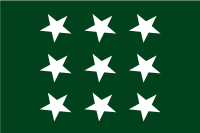Pakistan National Alliance
Pakistan National Alliance پاکستان قومی اتحاد | |
|---|---|
 | |
| Presidium | Abul A'la Maududi (JI) Shah Ahmad Noorani (JuP) Chaudhry Zahoor Elahi (PML) Asghar Khan (TeI) |
| Founded | 5 January 1977 |
| Dissolved | 24 January 1978 |
| Ideology | Conservatism Capitalism |
| Political position | Right-wing |
| Colors | Green |
| Slogan | Nizam-e-Mustafa (1977) |
| Party flag | |
 | |
The Pakistan National Alliance (Urdu: پاکستان قومی اتحاد, Acronym: PNA), was a populist and consolidated right and left political alliance, consisting of nine political parties of the country. Formed in 1977, the country's leading right-wing parties agreed upon to run a political campaign as a single bloc against the left oriented PPP in the 1977 general elections.
Despite each parties standing with a different ideology, PNA was noted for its large physical momentum and its right-wing orientation, originally aimed to oppose Prime Minister Zulfikar Ali Bhutto and the PPP.[1] Despite its right-wing populist agenda, the alliance performed poorly in the 1977 general election and levelled accusations of rigging the elections. After months of spontaneous violent political activism, the martial law came in effect under chief of army staff General Zia-ul-Haq who made call for a political retribution. By 1978, the alliance met its end when parties diverged in each of its agenda. The left-wing parties later would form the MRD alliance under PPP to oppose President Zia-ul-Haq in the 1980s and the right-wing forming the IDA alliance under PML.
History
[edit]The PPP came in power politics after the loss of East Pakistan in 1971. After uplifting the martial law in 1972 and promulgating the constitution in 1973, the PPP made slow efforts to advance the "Islam and democracy" in the country, but intensified the socialism with a vengeance.[2] First and foremost, the nationalisation program was carried out to centralise the large-scale industries, private-sector and commercial corporation to set up the strong state sector.[2] Resentment and heavy disapproval came from the elite corporate sector and PPP intensified its public programs at the social circles.[2] Although the general elections were to be held on half of 1977, Bhutto made a move and called for holding the general elections on 7 January 1977.[3]
Early calls for the elections were intended to not give the opposition enough time to make decisions and arrangements for the forthcoming elections.[3] Immediately after the announcement, Bhutto started his election campaign and began allotting party tickets to party's candidates.[3] Sensing the difficulty of facing PPP alone, the conservative mass began to consolidate when JeI contacting the Pakistan Muslim League (PML) and TeI.[4] The other small nine parties too joined the alliance and initially called for ending the era of stagflation in the country and its manifesto was to bring back the 1970 prices.[3]
On social views, the implementation of Islam was its primary election slogan. They promised to enforce Islamic laws "Nizam-e-Mustafa" and the Sharia laws.[4] The PNA's parties were a conglomerate of diverse views and of contradictory causes and united by common dislike of PPP's autocratic policies:
| PNA Divergence | ||||
|---|---|---|---|---|
| Political parties | Presiding leadership | Position | Color | Fate |
| Jamaat-e-Islami (JeI) | Abul A'la Maududi Mian Muhammad Tufail |
Right-wing | In alliance with Zia | |
| Pakistan Muslim League (PML) | Nawaz Sharif Chaudhry Zahoor Elahi Pir Pagara |
Centre right | In alliance with Zia | |
| Tehrik-e-Istiqlal (TeI) | Asghar Khan | Right | In opposition to Zia | |
| Jamaat Ahle Sunnat (JaH) | Ehsan Elahi Zaheer | Right | In alliance with Zia | |
| Jamiat Ulema-e-Pakistan (JUeP) | Shah Ahmad Noorani | Right | In alliance with Zia | |
| Pakhtun-khwa Milli Awami Party (MAP) | Mahmood Khan Achakzai | Left | In alliance with Zia | |
| Balochistan National Party (BNP) | Akbar Bugti | Left-wing | neutrality with Zia | |
| Awami National Party (ANP) | Khan Abdul Wali Khan | Left | In opposition to Zia | |
| Pakistan Democratic Party (PDP) | Nawabzada Nasrullah Khan |
centre-right | In alliance with Zia | |
Right-wing populism and violence
[edit]At this platform, the modern European style-influenced forces formed an alliance with totally opposite of hard-line Islamist forces.[3] The alliance decided to contest the elections under one election symbol "plough" and a green flag with nine stars as its ensign.[3]

Contesting the 1977 elections jointly the PNA launched a national campaign against the government after the controversial and allegedly rigged results showing the Peoples Party as an overwhelming victory in the general elections.[5] The agitation caught the Peoples Party and its political scientists, by surprise and after several months of street fighting and demonstrations. Under advised by his advisers, Bhutto opened negotiations with the then PNA leadership but whether or not it would have been signed by all PNA parties or by Bhutto remains open to speculation. In a single unusual anti-Bhutto bloc, the alliance seemed to be effective when tapping a wave to remove Bhutto from government.[5]
Meanwhile, Bhutto's trusted confident and a lifelong companion dr. Mubashir Hassan tried to handle the situation on behalf of Bhutto by bringing the alliance on a table to reach an agreement of co-existence and a vital political solution.[6] On other hand, Hassan advised Bhutto to not to rely either on establishment or use the force to curb the alliance.[6] An agreement was eventually reached in June 1977 and Bhutto was to sign it on 5 July.[6] However, despite the enthusiasm of the negotiating team, other PNA leaders had reservations about the agreement.[6] In response, Zulfiqar Ali Bhutto also tried to crush the power of this alliance, with the help of his agencies such as FSF and Rangers and for this reason was also considered for the cause of Bhutto's hanging on 4 April 1979.[6] In a coup staged by General Zia, Bhutto was removed from office with majority of his colleagues.[6]
Authoritarianism and PNA split
[edit]The conservatives and Islamist fronts went to General Zia-ul-Haq, Chief of Army Staff and Admiral Mohammad Shariff, Chairman of the Joint Chiefs of Staff Committee, and convinced them to remove Bhutto and no other agreement is reached with Bhutto and his colleagues remained stubborn.[6] The absence of a formal agreement between the government and the PNA was used as an excuse by the Pakistan Defence Forces under its chairman Admiral Mohammad Shariff which led to stage a Coup d'état (see Operation Fair Play) by General Zia-ul-Haq to break the impasse. Those justifying the coup, argue that no agreement had been reached between the two sides.[6]
Controversy regarding foreign support
[edit]On 5 July 1977, the PPP accused the United States of plotting the coup and maintained that the coup had tacit consent from the United States.[7] A few before the martial law, Bhutto had indicated that few foreign powers had been engineering his downfall, though he did not name which foreign powers.[7] Several Pakistani scholars and researchers have given credence to Bhutto's claim.[7][8] The veracity of these claims are difficult to verify since the United States has strongly rejected any claims of their involvement in downfall of Bhutto.[6][9] Though, former American Attorney General Ramsey Clark did questioned the "knowledge, hence the tacit approval" of the coup staged against the PPP.[6][10]
In 1998, Benazir Bhutto publicly announced her belief that her father was "sent to the gallows at the instance of the superpower (most believe it to be USA) for pursuing the nuclear capability,[11] though she did not disclosed the name of the foreign power.[11]
Alliance members
[edit]The Alliance unusually consisted of 9 main parties, with completely different ideologies, backgrounds, and political goals who opposed Bhutto and his government:
- Jamaat-e-Islami Pakistan (JI)
- Jamiat Ulema-e-Islam (JUI)
- Jamiat Ulema-e-Pakistan (JUP)
- National Democratic Party (NDP)
- Balochistan National Party (Mengal) (BNP)
- Muslim League (Qayyum) (PML-Q)
- Pakistan Muslim League (F) (PML-F)
- Pakistan Democratic Party (PDP)
- Tehrik-e-Istiqlal (TI)
- All Jammu and Kashmir Muslim Conference (MC)
- Khaksar Tehrik (led by Khan Muhammad Ashraf Khan)[12]
See also
[edit]- Islami Jamhoori Ittehad
- Politics of Pakistan
- History of Pakistan
- List of political parties in Pakistan
- Movement for Restoration of Democracy - a nine-party alliance formed to oppose Zia-ul-Haq
References
[edit]- ^ Navaz Sharif – A man between enemies Archived 11 August 2011 at the Wayback Machine
- ^ a b c Country studies US. "History of Pakistan Peoples Party and the Left in Pakistan". Country studies US. Retrieved 19 May 2013.
- ^ a b c d e f "1977 General elections and Right wing populism". Story of Pakistan press. June 2003. Retrieved 19 May 2013.
- ^ a b Lyon, Peter (2008). Conflict between India and Pakistan : an encyclopedia. Santa Barbara, Calif.: ABC-CLIO. p. 131. ISBN 978-1576077122.
- ^ a b Gerges, James Wynbrandt; foreword by Fawaz A. (2008). A brief history of Pakistan. New York: Facts on File. pp. 210–240. ISBN 978-0816061846.
{{cite book}}: CS1 maint: multiple names: authors list (link) - ^ a b c d e f g h i j Haqqani, Husain (2005). Pakistan : between mosque and military (1. print. ed.). Washington, DC: Carnegie Endowment for International Peace. ISBN 0870032143.
- ^ a b c Hussain, Rizwan (2005). Pakistan and the emergence of Islamic militancy in Afghanistan. Burlington, VT: Ashgate. pp. 80–82. ISBN 0754644340.
- ^ Nizamani, Haider K. (2000). The roots of rhetoric : politics of nuclear weapons in India and Pakistan (1. publ. ed.). Westport, Conn. [u.a.]: Praeger. ISBN 0275968774.
- ^ During Bhutto's five years in Pakistan's helm, Bhutto had retained an emotional hold on the poor masses who had voted him overwhelmingly in 1970s general elections. At the same time, however, Bhutto had many enemies. The [socialist economics] and nationalization of major private industries during his first two years on office had badly upsets the Business circles... An ill-considered decision to take over the wheat-milling, rice-husking, sugar mills, and cotton-gaining, industries in July 1976 had angered the small business owners and traders. Both leftists— socialists and communists, intellectuals, students, and trade unionists— felt betrayed by Bhutto's shift to centre-right wing conservative economics policies and by his growing collaboration with powerful feudal lords, Pakistan's traditional power brokers. After 1976, Bhutto's aggressive authoritarian personal style and often high-handed way of dealing with political rivals, dissidents, and opponents had also alienated many.... Quoted by the United States on Bhutto's and PNA alliance tug of war politics
- ^ "I [Ramsey Clark] do not believe in conspiracy theories in general, but the similarities in the staging of riots in Chile (where the CIA allegedly helped overthrow President Salvadore Allende) and in Pakistan are just too close, Bhutto was removed from power in Pakistan by force on 5 July, after the usual party on the 4th at the U.S. Embassy in Islamabad, with U.S. approval, if not more, by General Zia-ul-Haq.[119] Bhutto was falsely accused and brutalized for months during proceedings that corrupted the Judiciary of Pakistan before being murdered, then hanged. As Americans, we must ask ourselves this: Is it possible that a rational military leader under the circumstances in Pakistan could have overthrown a constitutional government, without at least the tacit approval of the United States?" Quoted by former U.S. Attorney General Ramsey Clark
- ^ a b Malick, Nasir Malick (10 May 1998). "Benazir vows to fight on people's side". DawnWireService (DWS). Archived from the original on 17 December 2020. Retrieved 17 November 2011.
- ^ The Far East and Australasia 2003. Europa Publications. 2002. p. 1163. ISBN 978-1-85743-133-9.
